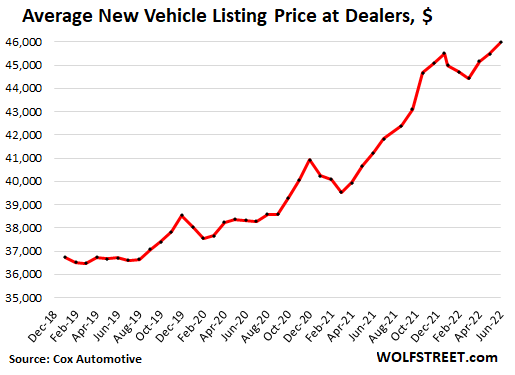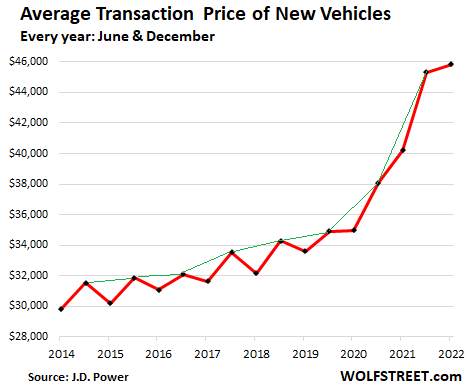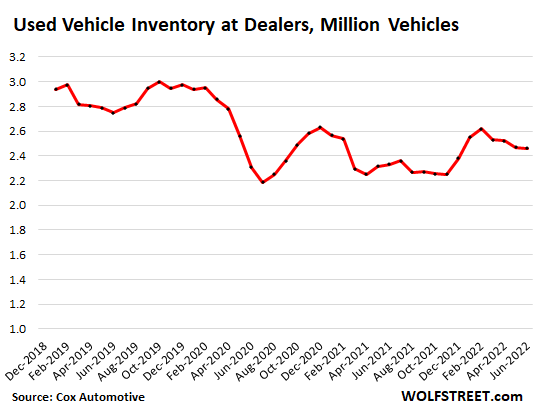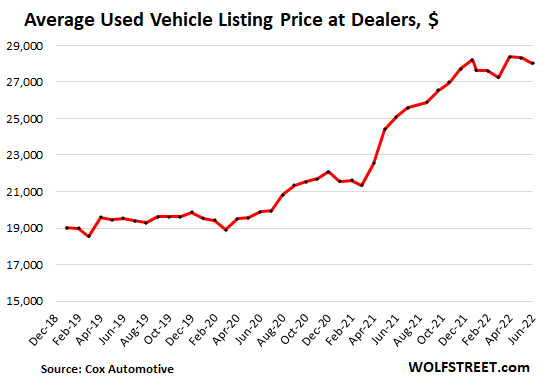Still the strangest auto market ever.
By Wolf Richter for WOLF STREET.
The inventory shortages at new vehicle dealers continue unabated, and inventories remain desperately low, but the shortages are shifting, as demand has shifted, and there is now supply piling up, for example at Ram dealers, while fuel-efficient vehicles are essentially sold out, and EV models have long waiting lists – as people are tired of getting hammered by high fuel prices.
The number of new vehicles in “in stock” on dealer lots and “in transit” to dealers dipped to 1.12 million vehicles at the end of June, down by 70%, or by 2.61 million vehicles, from the same period in 2019, according to estimates by Cox Automotive, based on its Dealertrack data. On this basis, new vehicle inventories haven’t improved since December. By comparison, in 2019, new vehicle inventory averaged 3.66 million vehicles.
The term “inventory” accounts for what is “in stock” and what is “in transit.” And it may include units that have been pre-sold. A dealer’s website typically shows three labels next to the vehicles in their inventory: “in stock,” “in transit,” and “sold.”
The relentless new-vehicle price spike.
The average asking price (listing price) shows that dealers are in no mood to offer deals yet. The average listing price in June rose 11.5% from a year ago, to a record $45,976, according to Cox Automotive.
Cox also said that during the last week of June, asking prices “began to retreat slightly.” So maybe possibly perhaps, dealers are running into just a tad of price resistance in certain corners of the market.
Asking prices fell in January, February, and March, only to do a U-Turn in April – and part of this was seasonal as January and February are the worst months for dealers, when volume tends to plunge from the December binge. By June, they hit a new record, up by 11.5% year-over-year. This still speaks of a hot under-supplied market:
The average transaction price – the price at which vehicles were sold and delivered – jumped by 14% year-over-year, to a record $45,844 in June, according to J.D. Power data. Compared to June 2019, this was up by 36% or by over $10,000.
At these prices, dealers made record gross profits per vehicle delivered. Including finance and insurance sales (F&I), dealers made on average $5,123 in gross profit per vehicle, up by $1,174 from the already high levels of June 2021, according to J.D. Power estimates.
The chart shows ATPs for December and June of each year. Before the pandemic, there was an established seasonality, where the ATP hit a high in December but dropped from there to June every year. But in June 2020, the ATP in June was level with December for the first time. And in 2021 and 2022, the ATP just jumped from December to June without regard to seasonality. The green line connects the Decembers:
Shortages of fuel-efficient vehicles. No shortages at Dodge & Ram dealers.
Plenty of supply at Dodge and Ram dealers: Including in stock and in transit, Dodge dealers ended June with 90 days’ supply, and Ram dealers with 81 days’ supply. The industry considers 60 days about ideal between tight and sufficient.
Fuel efficient vehicles essentially out of stock. At the low end of supply in the non-luxury segments were the Asian brands with fuel-efficient models that were essentially out of stock: Toyota Corolla, Kia Telluride, Toyota Camry, Hyundai Palisade, and Kia Sportage.
At the low end of supply by segment:
- Hybrids, 17 days’ supply
- Mid-size cars, 22 days’ supply
- Compact cars: 24 days’ supply.
Supply of full-size pickups is growing: At the high end of the 30 top-selling models were three pickup trucks and two SUVs: Ram 1500 (79 days), Ford Escape (69 days), followed by Jeep Compass, Ford F-150, and Chevrolet Silverado.
This is now a new inventory problem: the wrong inventory. Through 2020 and 2021, pickup trucks were particularly hard to get, and everyone wanted them. But then gas prices spiked, and suddenly the cost of filling up become one of the purchase considerations, and pickup trucks lost their edge. Demand swiveled to more fuel-efficient vehicles.
But due to the long and complex supply chains, automakers cannot instantly swivel with shifts in demand. And the supply issues, triggered by the semiconductor shortage, have taken on a new dimension through this shift in demand to more fuel-efficient models that automakers were not prepared for.
Used Vehicles: Plenty of supply.
The inventory at used-vehicle dealers, at 2.46 million vehicles at the end of June, was up by 5.5% from a year ago. Compared to 2019, it was down only 10%.
But sales have been lower for months, compared to 2021 and to 2019, as buyers have started to resist the sky-high prices. And days’ supply at the end of June, given the lower rate of sales, edged up to 49 days, just a tad above the average in 2019 (48 days).
Used vehicles: Crazy price spike runs out of fuel.
Between December 2019 and December 2021, over those two years, the average asking price for used vehicles spiked by 42%, or by $8,300 per vehicle, from $19,871 in December 2019 to $28,205 in December 2021, which was totally nuts, and that’s where resistance finally started kicking in.
By June, the average asking price dipped to $28,012, just a little below December. Declines in January, February, and March are seasonally normal, but declines in May and June are not. And by the looks of it, the completely crazy price spike may finally have run out of fuel.
But there is still no over-supply. The inflow into the used vehicle market from rental fleets has been tempered by production shortfalls of new vehicles for rental fleets, and they’re slower in turning over their fleets. And wholesale prices, though they’ve dipped from the spike through December, are still sky-high. In this environment, dealers are not motivated yet to cut prices by a whole bunch in order to move the iron. But at least the price spike has run out of fuel.
Enjoy reading WOLF STREET and want to support it? Using ad blockers – I totally get why – but want to support the site? You can donate. I appreciate it immensely. Click on the beer and iced-tea mug to find out how:
Would you like to be notified via email when WOLF STREET publishes a new article? Sign up here.




